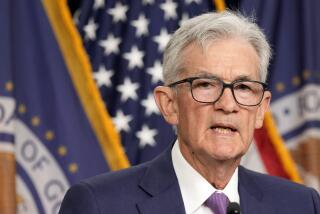Brazil Comes Bouncing Back
- Share via
Barely three months ago, Brazil was driven to the brink of economic disaster after the government’s decision to let its currency “float” promptly sent the real floating down a black hole.
As the real lost 44% of its value against the dollar and interest rates soared, there were dire predictions of a debt default, hyperinflation, capital controls, and a region-wide plunge that would make Latin America the next victim of the global financial crisis that began in Asia in mid-1997.
Today, Brazil appears to be in the early stages of a dramatic turnaround. While not out of the woods, its currency is strengthening, interest rates are declining, inflation has been held in check and the country is generating new confidence at home and abroad that it can emerge relatively rapidly from its recession, possibly this year.
Among other things, Brazil owes its incipient turnaround to a little bit of luck, to some effective international jawboning by its new central bank chief, and to the surprisingly moderate inflation since the devaluation, analysts said.
“All those pessimistic expectations of all those brilliant economists who didn’t know Brazil were frustrated,” said Alexandre Azara, economist with BBA-Creditanstalt of Sao Paulo.
Said Arturo Porzecanski, economist at ING Barings in New York: “Brazil is showing that it was possible for an emerging market country to have a devaluation and live to tell about it.”
Brazil’s latest good tidings came Wednesday when the central bank lowered its key interest rate by 5.5 percentage points to 34%, the third cut in three weeks, and hinted of more to come. The rate cuts make everyone happy, from consumers and businesses to the debt-strapped government.
Also encouraging is the Brazilian real’s added strength, to Thursday’s close of 1.665 to the dollar from as weak as 2.15 in mid-February. On Jan. 12, before the devaluation, the real traded at 1.21, so it has now regained more than half its losses.
Brazilian bond prices have edged up and stock prices have soared 66% since January. The leading index, the Bovespa, closed Thursday at 11,245, down a fraction. Brazil’s success has proven infectious, with stock markets in Argentina and Chile also rebounding.
“We’re beginning to see some favorable elements emerge in the Brazilian economyand that’s taking the heat off a number of countries, notably Argentina,” which relies heavily on Brazilian trade, said Larry Goodman, managing director of Global Economic Associates in New York. Brazil’s economy may have passed a “turning point” in early March, he added.
Goodman is also encouraged by the shrinking trade deficit, which is projected tototal $17 billion this year -- down by half from last year -- as the devaluation makesexports more competitive and imports less affordable.
But the best news in a country so recently bedeviled by hyperinflation is that price increases have been surprisingly modest since January, despite the price pressure that a 40% devaluation inherently causes. Many experts feared a recurrence of the days of quadruple-digit inflation when the currency lost value by the minute, destroying savings and confidence.
Inflation for the first quarter this year averaged just 1% a month and could fall to zero or negative figures in April, a trend cited by the central bank in its decision to lower interest rates.
BBA-Creditanstalt’s Azara said inflation has stayed low in part because Brazil had the “luck” to already be in a recession when the devaluation hit. Consumers, rather than paying inflated prices for imports and other goods affected by the weaker real, simply didn’t buy.
And retailers, all too aware that Brazilians’ purchasing power was anemic, generally didn’t “re-price” goods as much as was feared, Azara said.
Brazil is also benefiting from the inflation-fighting monetary strategy laid out by new central bank chief Arminio Fraga. He was apparently quite a hit on a “road show” to U.S. and European banks last month to convince them that Brazil would survive its latest crisis.
The February appointment of Fraga, a former lieutenant to financier George Soros, was hailed by the investment community. One result has been increased access to foreign credit from multinational banks to corporate borrowers in Brazil -- another reason cited by the central bank in justifying Wednesday’s rate cut. The fear that credit would disappear, causing massive defaults by Brazilian borrowers, is rapidly receding, said Gary Hufbauer of the Institute for International Economics in Washington.
But Hufbauer and others cautioned that Brazil still has much work to do in reining in its enormous public-spending deficit, which amounts to 10% of economic output. Bloated public payrolls and the money-losing social security system must be trimmed down.
“The problem with Brazil is that it usually becomes very complacent very quickly when markets become more friendly,” said Jorge Mariscal, chief Latin America strategist at Goldman Sachs in New York. “So I hope they don’t read into the benign conditions that the market will let them forget what they promised to do to cut the deficit.”
(BEGIN TEXT OF INFOBOX / INFOGRAPHIC)
Reason to Samba
After a disastrous currency devaluation in January fueled by fears over soaring government deficits, Brazil looks to be recovering far faster than expected -- as the currency rebounds, stocks soar and interest rates fall back.
A Rebound for the Real
Brazilian reals per U.S. dollar, weekly closes and latest:
Thursday: 1.66
...Helps Power Stocks...
Bovespa index of the Sao Paulo exchange, monthly closes and latest:
Thursday: 11,245.55
...and Lets Rates Slide
Key short-term interest rate of the Brazilian central bank, weekly closes and latest:
April 16: 34.04%
Source: Bloomberg News, CitiBank
More to Read
Sign up for Essential California
The most important California stories and recommendations in your inbox every morning.
You may occasionally receive promotional content from the Los Angeles Times.












